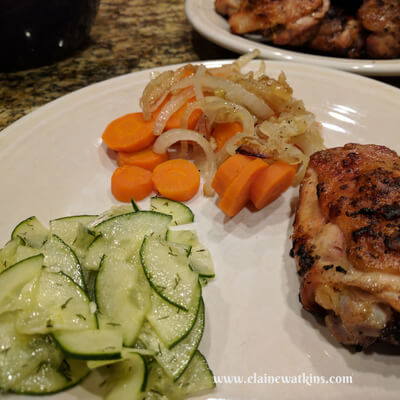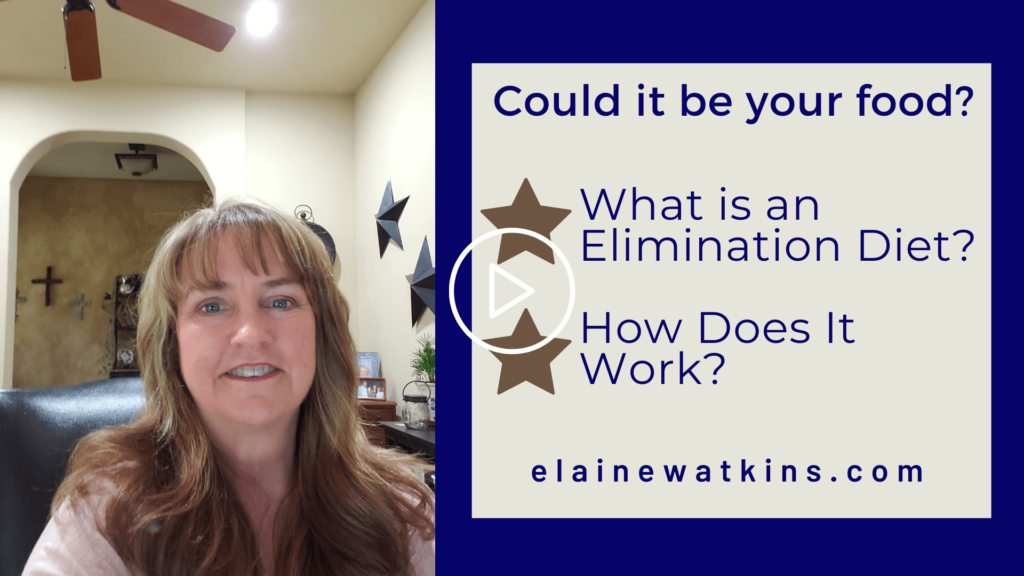Could It Be Your Food? What is an Elimination Diet and How Does it Work?

I get into a lot of conversations where someone shares the health challenges they are dealing with and really don’t know what to do. Some have even completed some labs. Some may already be taking medications to help with the symptoms to manage their situation but don’t feel better. There’s been no real discussion about diet or lifestyle most of the time, so the question, what is an elimination diet? hasn’t even come up.
There might have been a comment thrown in near the end of an appointment, as the person is being handed a prescription, to cut back on sugar or start exercise, but that’s it.
THIS is why I’m a health coach!!!
This is exactly where I was not so long ago.
Let’s Consider
Of course, every situation is different, but suffice it to say, you need to start at the beginning.
It reminds me of the illustration of an overflowing sink and all kinds of practitioners, specialists, and support staff are mopping up the floor with mops, sponges, rags, and more. Then, eventually, a coach walks in and turns off the faucet.
Simple but effective.
But what’s the actual goal of the person experiencing the symptoms? Most people want to feel better. They want their problem to be fixed, not covered up and allowed to worsen.
Food is one of the first steps and a necessary data point to determining health, illness, and recovery, and, oftentimes, an elimination diet can be a powerful tool for making connections and smart changes.
Let me explain.
The 3-Legged Stool
Something that’s often mentioned in many functional medicine and integrative health discussions is a simple comparison to a 3-legged stool. I think the first time I heard it referenced was from Dr. Alessio Fasano. As a world-renowned gastroenterologist, when talking about autoimmune disease and food sensitivities, he explained the 3 legs as representing:
- genes – how they can be restricting/enabling beneficial and problematic functions, pathways, and systems
- environment – how potential triggers including from our food can cause inflammation and disease
- digestive health – how diet (along with stress and other triggers) can nourish or weaken your digestive functions and lead to intestinal permeability or leaky gut and subsequent symptoms and disease
What is an Elimination Diet?
Food choices are not always considered as a possible influencer of our health, but each bite you take is either:
- life-supporting, beneficial fuel for healthy function or
- health-inhibiting toxin that can cause injury and inhibit healthy function
With the typical western diet, nutrients are usually scarce or limited. Oftentimes inflammatory foods are abundant, and non-food substances are common and harmful too.
Dr. Tom O’Bryan in his book, You Can Fix Your Brain, hones in on the primary benefit of an elimination diet:
…you need to identify the foods to which you are sensitive and eliminate them from your diet. By doing so, not only do you stop throwing gasoline on the fire, reducing the inflammatory cascade, but your body also begins flushing out the stored toxins in your fat cells.
Dive A Little Deeper
You’re probably familiar with allergies and the immediate, and sometimes extreme, reactions that some people have. There are, however, other types of responses that you can have that are often not so obvious or connectable. Problems, noticeable or not, can appear days after the exposure and can last for days, weeks, and even months.
Can you imagine linking your indigestion to something you ate 2 days ago? What if you eat something from that food group every day?
But think about it. If you had a thorn in your foot, it would hurt, right? Taking the thorn out, the pain would lessen, but you would probably still have pain. If you took the thorn out and then gave yourself time to recover, you would probably enjoy a complete recovery. Relate that to a food that’s causing a problem. You eliminate the food, so the cause of the problem is gone. The battle going on inside your body to fight that problem can calm down. With a little time and with the problem gone, you now have a chance to improve.
An elimination diet can reveal much about what is working and what might not be working for you.
What is an Elimination Diet?
I see an elimination diet as having four parts:
- experiencing problems and creating a plan to find your solution
- eliminating potentially problematic foods and food groups while building a health-supporting selection of meal and snack options
- reintroducing the foods and food groups and watching for returning symptoms
- creating a new and sustainable diet strategy without the problem foods and food groups
Eliminate What?
We are all uniquely created. Your genes, microbiome, current and past exposures and environment all contribute to what makes you you.
While you can potentially have a problem with just about any food, there are a few foods and food groups that tend to a problem more often. Those are:
- Gluten
- Dairy
- Eggs
- Sugar
- Corn
- Peanuts
- Soy
- Processed foods
- Grains
Depending upon your situation and whether you’re following a particular protocol or a more individualized plan, you might eliminate just one or more of these (or others) foods.
1. Experiencing Problems and Creating a Plan
Because everyone is different, we each have a different experience when we come to realize there’s a problem and the actions we take in response.
You might notice symptoms like adult acne, period changes, weight loss difficulties, anxiety, gas, fatigue, pain, congestion, nausea, hair loss, and many more. From that point you might change your personal care products, join a weight loss program, see a practitioner, start over the counter or prescribed medications, read a book, or call a health coach, but somewhere in this phase, you realize an elimination diet might be helpful.
The research is done either by you or your health coach. Most of the time, there is already some sense that there is a problem with the particular food, but not always. In some situations, a food might be excluded without a visible connection but that has some underlying thread connecting it to the symptoms being experienced. From the information and observations you have, a strategy is set, supplies and ingredients are bought, and the start date is set.

2. Eliminating potentially problematic foods and food groups
In the elimination phase, you are excluding certain foods or food groups from your diet completely for a period of time.
Depending upon the situation, a single food, like eggs, might be excluded. Other times a food group, like gluten, is elimination. It’s also common to eliminate more than one food or food group due to the combination of symptoms.
By eliminating potentially problematic foods, you allow a time for healing, toxin reduction, and nourishment while watching how your body responds in the absence of potentially harmful foods or food groups.
Most elimination diets typically run for 3 weeks, 1 month, or 6 weeks, but some practitioners and programs might recommend a different schedule depending on the situation or an existing program.
During this time, you are also flooding your body with nutrient dense, real food to support healing and recovery of your health while also feeling satiated You are also usually discovering new foods, alternative ingredients, and new recipes. Enjoy real foods in all colors flooding your senses with new flavors and smells as much as possible. Eating in a relaxed state is also helpful.
3. Reintroducing the foods and food groups

In the reintroduction (or some call it the provocation) phase, the eliminated foods are reintroduced one at a time. Several elimination diets recommend reintroducing and eating a food for 3-7 consecutive days while continuing to track symptoms and changes.
If no problems are noticed after seven days, then the next recommended food is reintroduced in the same way. If a problem is experienced when a food is reintroduced, that food is usually removed immediately.
Depending on the food, most can be retried after all other foods have been reintroduced, but sometimes a strong recovery is seen once a food is eliminated that might be cause to not reintroduce a food or food group. Gluten might be a good example of this if you have discovered you react to gluten severely, as in the case of someone that might have Celiac or a significant sensitivity.
And don’t be surprised when unexpected recoveries occur. An example of an expected change was quickly realized by a client-friend of mine that had constant, painful breakouts in the upper neck/hairline area and had those blemishes disappear in approximately two weeks after removing dairy from his diet.
An unexpected example that I personally experienced when I eliminated gluten was the end of pain in my lower legs and feet. Gone. Completely.
Additional Resources
Additionally, I recommend doing your research first. Some great resources include:
- This informative video by Dr. David Jockers
- This informative article by Dr. Josh Axe
- My informative post, What Is Autoimmune Disease? that you might also find helpful
Tracking
![]() Tracking throughout all phases of your elimination diet can provide helpful information that can guide in making connections and adjustments.
Tracking throughout all phases of your elimination diet can provide helpful information that can guide in making connections and adjustments.
The more you track, the more information you collect about what you eat, what you do, and what you notice about your body each day before, during, and after each meal.
Also know that it’s not just food that affects your health. While we are focused on food here, I do want to remind you that other exposures and choices contribute to your health.
Whether you get in an argument with your partner, have minimal activity during the day, enjoy a relaxing dinner with friends, or maybe you’re challenged to a fun game of fetch with your dog. It can all contribute to your overall health.
CLICK HERE and get my DAILY TRACKER!
You’ll see it in the details of your every day!
4. Creating a new and sustainable diet strategy
 As you come to the end of your elimination diet, you are armed with new information about yourself and have made smart changes with that information that can support your healthy future from here on.
As you come to the end of your elimination diet, you are armed with new information about yourself and have made smart changes with that information that can support your healthy future from here on.
You might have discovered that you have a:
- problem with a particular food
- problem with a particular food right now only because of the overload your body is dealing with and are now reducing
- possible need to eliminate something that you didn’t originally investigate
- something else going on that might be affected by food but originates elsewhere
- combination of some or all of these.
Depending upon your results, maybe you’ll complete a second, restyled elimination diet due to some of the information you gathered? Maybe you made the connections you needed, and your symptoms are fading or are completely gone and you’re healing.
Whatever the case, elimination diets can be a budget-friendly tool that can also give you information that can help you support your health journey.
But don’t be surprised if you have a few surprises along the way.
The personal example I shared a few paragraphs earlier was Not something I connected to my diet. I thought the pain in my legs and feet were due to my expanding daily workouts. Of course, I didn’t know I even had an autoimmune issue or that gluten was a problem.
A Few Suggestions as You Prepare
Some foods are literally addictive and can be difficult to let go. For this reason, be sure to:
- stock up with ready to access “safe” snacks and meal options
- consider completely removing or relocating eliminated foods from your home or pantry (if possible)
- plan and prepare your meals and snacks ahead of time
- encourage the participation of other family members to enjoy shared discovery and support
While you are probably doing this to explore possible links between symptoms you might be experiencing and the foods you eat, have fun with this. Explore and experiment. Who knows what new favorite you might discover?
I’ve never liked peanuts…in any form. When I went through my first elimination diet, eliminating peanuts (and peanut butter) was not a problem. I began to learn about the health benefits of various tree nuts, though, and soon discovered that I L.O.V.E. almond butter.
Summing It Up
If you decide that an elimination diet is something you want to explore, remember:
- Do your research including checking with your practitioner or get the help of your health coach
- Decide what food group/groups would be wise to eliminate
- Choose when to schedule your elimination diet and for how long
- Invite family and friends to join you for fun and support
- Stock your kitchen and plan your meals and snacks
- Track routines and changes (CLICK HERE FOR THAT TRACKER)
- When reintroducing, continue to track and stop the reintroduction of a food if there’s a problem
- Make adjustments and set goals based on your findings
- Realize that an elimination diet might be just the first step in discovering and making changes that can really change your life
Want Help?
Would you like some help with implementing an elimination diet and gathering data that will support your health?
As a Nutritional Endocrinology Coach, I can provide you with information, resources, and work with you to build a plan that works.
If you’re interested in scheduling a free Discovery Call to learn more about how coaching works, CLICK HERE or the blue “Is Coaching for You?” button below to set up our call.
And Finally
I understand this might be a bit scary. It will mean stepping out of your comfort zone.
But remember…
You have power to make choices every day that might be zapping your energy, clear-thinking, freedom from pain, hormones happiness, and healthy weight achievement.
You also have the power to arm yourself with information that can help you make choices for a healthier future.



Very informative. Sounds like it’s time for a change.
Thank you.
I have been wanting to do this FOREVER! Awesome post. 🙂
So glad you found this helpful.